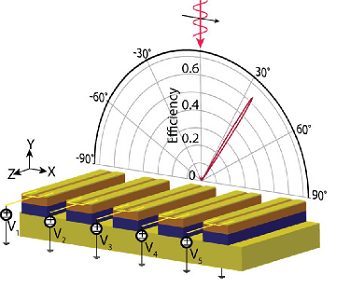Today’s most sophisticated microscopes, telescopes, and other optical instruments share a fundamental similarity with millennia-old technology which use curved surfaces to bend and redirect light rays. Light rays acquire different phases, when passing through or reflecting of different regions of a surface, due to path length variations. In metasurfaces this phase variation is achieved with nanoscale patterning, enabling miniaturized optical components compatibility with complementary metal-oxide-semiconductor manufacturing. Although metasurfaces can be designed for an astonishing array of purposes, that purpose is “set in stone” once the surface is patterned. UC Santa Barbara researchers Prasad Iyer and Prof. Jon Schuller propose a new route, novel electrically reconfigurable metasurfaces, as an important step towards on-chip programmable optics.
 Electrically reconfigurable metasurfaces require generating large phase shifts in subwavelength elements. This requirement is at odds with conventional electro-optics, where small changes in materials properties are integrated over large distances (i.e. many wavelengths). Iyer’s and Schuller’s device exploits the ultra-small electron mass in indium antimonide to achieve large changes in the refractive index with moderate changes in electron density. The advantageous properties of indium antimonide are combined with a novel heterojunction device that enables the necessary modulation of electron density. The UC Santa Barbara researchers design and simulate subwavelength “mie resonators” whose reflection phase can be continuously varied between 0 and 300° with an applied voltage. Using combined device and electromagnetic simulations they ultimately demonstrate steering of an infrared beam with high diffraction efficiency.
Electrically reconfigurable metasurfaces require generating large phase shifts in subwavelength elements. This requirement is at odds with conventional electro-optics, where small changes in materials properties are integrated over large distances (i.e. many wavelengths). Iyer’s and Schuller’s device exploits the ultra-small electron mass in indium antimonide to achieve large changes in the refractive index with moderate changes in electron density. The advantageous properties of indium antimonide are combined with a novel heterojunction device that enables the necessary modulation of electron density. The UC Santa Barbara researchers design and simulate subwavelength “mie resonators” whose reflection phase can be continuously varied between 0 and 300° with an applied voltage. Using combined device and electromagnetic simulations they ultimately demonstrate steering of an infrared beam with high diffraction efficiency.
The demonstration of continuous beam steering is one of many possible applications of this proposed device. More generally, the ability to engineer arbitrary spatial phase profiles provides unprecedented control of the electromagnetic wavefront. Namely, the UC Santa Barbara researchers Prasad Iyer and Prof. Jon Schuller envision a programmable infrared device that can mimic any linear optical element and be reconfigured at electronic timescales.

















